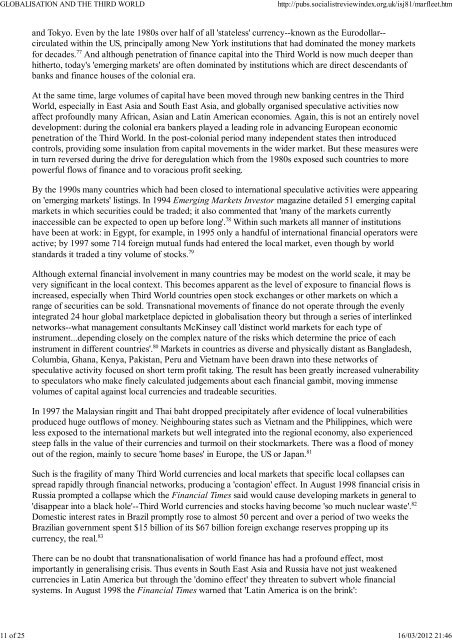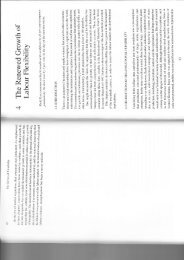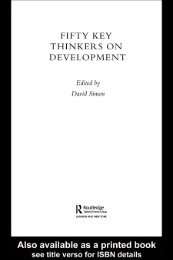GLOBALISATION AND THE THIRD WORLD.pdf - Steerweb.org
GLOBALISATION AND THE THIRD WORLD.pdf - Steerweb.org
GLOBALISATION AND THE THIRD WORLD.pdf - Steerweb.org
You also want an ePaper? Increase the reach of your titles
YUMPU automatically turns print PDFs into web optimized ePapers that Google loves.
<strong>GLOBALISATION</strong> <strong>AND</strong> <strong>THE</strong> <strong>THIRD</strong> <strong>WORLD</strong>http://pubs.socialistreviewindex.<strong>org</strong>.uk/isj81/marfleet.htm11 of 25 16/03/2012 21:46and Tokyo. Even by the late 1980s over half of all 'stateless' currency--known as the Eurodollar--circulated within the US, principally among New York institutions that had dominated the money marketsfor decades. 77 And although penetration of finance capital into the Third World is now much deeper thanhitherto, today's 'emerging markets' are often dominated by institutions which are direct descendants ofbanks and finance houses of the colonial era.At the same time, large volumes of capital have been moved through new banking centres in the ThirdWorld, especially in East Asia and South East Asia, and globally <strong>org</strong>anised speculative activities nowaffect profoundly many African, Asian and Latin American economies. Again, this is not an entirely noveldevelopment: during the colonial era bankers played a leading role in advancing European economicpenetration of the Third World. In the post-colonial period many independent states then introducedcontrols, providing some insulation from capital movements in the wider market. But these measures werein turn reversed during the drive for deregulation which from the 1980s exposed such countries to morepowerful flows of finance and to voracious profit seeking.By the 1990s many countries which had been closed to international speculative activities were appearingon 'emerging markets' listings. In 1994 Emerging Markets Investor magazine detailed 51 emerging capitalmarkets in which securities could be traded; it also commented that 'many of the markets currentlyinaccessible can be expected to open up before long'. 78 Within such markets all manner of institutionshave been at work: in Egypt, for example, in 1995 only a handful of international financial operators wereactive; by 1997 some 714 foreign mutual funds had entered the local market, even though by worldstandards it traded a tiny volume of stocks. 79Although external financial involvement in many countries may be modest on the world scale, it may bevery significant in the local context. This becomes apparent as the level of exposure to financial flows isincreased, especially when Third World countries open stock exchanges or other markets on which arange of securities can be sold. Transnational movements of finance do not operate through the evenlyintegrated 24 hour global marketplace depicted in globalisation theory but through a series of interlinkednetworks--what management consultants McKinsey call 'distinct world markets for each type ofinstrument...depending closely on the complex nature of the risks which determine the price of eachinstrument in different countries'. 80 Markets in countries as diverse and physically distant as Bangladesh,Columbia, Ghana, Kenya, Pakistan, Peru and Vietnam have been drawn into these networks ofspeculative activity focused on short term profit taking. The result has been greatly increased vulnerabilityto speculators who make finely calculated judgements about each financial gambit, moving immensevolumes of capital against local currencies and tradeable securities.In 1997 the Malaysian ringitt and Thai baht dropped precipitately after evidence of local vulnerabilitiesproduced huge outflows of money. Neighbouring states such as Vietnam and the Philippines, which wereless exposed to the international markets but well integrated into the regional economy, also experiencedsteep falls in the value of their currencies and turmoil on their stockmarkets. There was a flood of moneyout of the region, mainly to secure 'home bases' in Europe, the US or Japan. 81Such is the fragility of many Third World currencies and local markets that specific local collapses canspread rapidly through financial networks, producing a 'contagion' effect. In August 1998 financial crisis inRussia prompted a collapse which the Financial Times said would cause developing markets in general to'disappear into a black hole'--Third World currencies and stocks having become 'so much nuclear waste'. 82Domestic interest rates in Brazil promptly rose to almost 50 percent and over a period of two weeks theBrazilian government spent $15 billion of its $67 billion foreign exchange reserves propping up itscurrency, the real. 83There can be no doubt that transnationalisation of world finance has had a profound effect, mostimportantly in generalising crisis. Thus events in South East Asia and Russia have not just weakenedcurrencies in Latin America but through the 'domino effect' they threaten to subvert whole financialsystems. In August 1998 the Financial Times warned that 'Latin America is on the brink':




